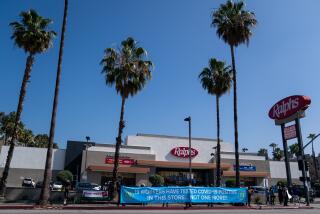Bricklayer To Market King
- Share via
When the Ralphs family left Missouri in a covered wagon to settle in Los Angeles in the 1850s, George A. Ralphs, then a young boy, began serving an apprenticeship at the bricklayer’s trade.
The future founder of Ralphs’ grocery chain worked on some of the pioneer structures of the city and became such an expert at his trade that he soon became known as the Champion Bricklayer of California. He earned the title by participating in numerous open competitions, always coming out on top.
Forced to leave the building trade because of a hunting accident that deprived him of one of his hands, Ralphs became a clerk in a small grocery store at 5th and Hill streets, owned by a man named Francis. He later used his savings to enter into partnership with Francis on another store at 6th and Spring streets.
In 1879, the Francis interests were bought out by Walter B. Ralphs, George’s brother, and the business became known for many years as Ralphs Bros. Grocers. The business was incorporated in 1906 as Ralphs Grocery Company.
The first problem the brothers faced in the development of their successful operation was the question of supply and demand. The dilemma was in meeting its customers’ growing needs at reasonable prices.
Their answer was a novel scheme, both daring and innovative. They provided lodging for farmers and stabling for their horses, an opportunity which attracted so many enthusiastic sellers that Ralphs was able to buy whole crops at one time, thus enabling the store to reduce costs to customers.
Though Walter left the company for a career in real estate, the brothers’ business philosophy was established.
After 1911, new branches were started and in 1923 the company opened a new store and executive office in a building formerly occupied by the Good Samaritan Hospital. Former patients’ rooms became storage space for sugar, rice and coffee, the operating rooms were turned into offices, and the morgue refrigeration system in the basement proved convenient for spoils.
There was a radical departure in architectural design of the stores following the major 1933 earthquake.
Unobstructed curved roofs, large plate glass windows, wider aisles and bigger parking lots became the signature of the evolving supermarket and Ralphs, with its 128 branches in the Southland, was at the forefront of the movement.
More to Read
Inside the business of entertainment
The Wide Shot brings you news, analysis and insights on everything from streaming wars to production — and what it all means for the future.
You may occasionally receive promotional content from the Los Angeles Times.










